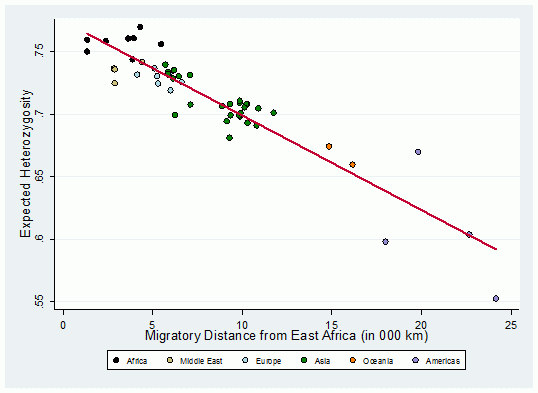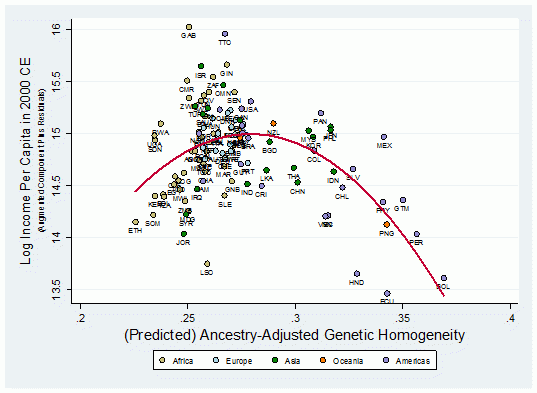Existing theories of comparative development seek to explain the vast inequality in living standards around the world. The importance of geographical, cultural and institutional factors, human capital formation, ethnic, linguistic, and religious fractionalisation, colonialism and globalisation have all been at the centre of a debate regarding the origins of the differential timing of transitions from stagnation to growth and the remarkable transformation of the world income distribution in the last two centuries.
While theoretical and empirical research has typically focused on the effects of such factors in giving rise to and sustaining the Great Divergence in income per capita in the pre-industrial era (see for example Diamond 1997), attention has recently been drawn towards some deep-rooted factors that have been argued to affect the course of comparative economic development.
From the cradle of humankind to the present day
Our recent research argues that deep-rooted factors, determined tens of thousands of years ago, have had a significant effect on the course of economic development from the dawn of human civilisation to the present day (Ashraf and Galor 2011).1 In particular, our research advances and empirically establishes the hypothesis that, in the course of the exodus of Homo sapiens out of Africa, variation in migratory distance from the cradle of humankind in East Africa to various settlements across the globe affected genetic diversity and has had a long-lasting hump-shaped effect on the pattern of comparative economic development that is not captured by geographical, institutional, or cultural factors.
Consistent with theoretical predictions, the empirical analysis finds that the level of genetic diversity within a society has a hump-shaped effect on development outcomes in the pre-Columbian as well as in the modern era, reflecting the trade-off between the beneficial and the detrimental effects of diversity on productivity. While the intermediate level of genetic diversity prevalent among the Asian and European populations has been conducive for development, the high degree of diversity among African populations and the low degree of diversity among Native American populations have been a detrimental force in the development of these regions.
Building the hypothesis
The hypothesis rests upon two fundamental building blocks.
- First, migration distance reduces genetic diversity.
Distance from the cradle of humankind in East Africa is associated with lower genetic diversity within ancient indigenous settlements across the globe.
Following the prevailing hypothesis, commonly known as the serial-founder effect in the field of population genetics, it is postulated that, in the course of human expansion over planet Earth, as subgroups of the populations of parental colonies left to establish new settlements further away, they carried with them only a subset of the overall genetic diversity of their parental colonies (Ramachandran et al. 2005). Indeed, as depicted in Figure 1, migratory distance from East Africa has an adverse effect on genetic diversity (expected heterozygosity) in the 53 ethnic groups across the globe that constitute the Human Genome Diversity Cell Line Panel.
Figure 1. Genetic diversity (expected heterozygosity) and migratory distance from East Africa
- Second, there exists an optimal level of diversity for economic development.
This reflects the interplay between the conflicting effects of diversity on the development process. The adverse effect pertains to the detrimental impact of diversity on the efficiency of the aggregate production process of an economy. Heterogeneity increases the likelihood of mis-coordination and distrust, reducing cooperation and disrupting the socioeconomic order. Greater population diversity is therefore associated with the social cost of a lower total factor productivity, which inhibits the ability of society to operate efficiently with respect to its production possibility frontier.
The beneficial effect of diversity, on the other hand, concerns the positive role of diversity in the expansion of society's production possibility frontier. A wider spectrum of traits is more likely to be complementary to the development and successful implementation of advanced technological paradigms. Greater heterogeneity therefore fosters the ability of a society to incorporate more sophisticated and efficient modes of production, expanding the economy's production possibility frontier and conferring the benefits of increased total factor productivity.
Higher diversity in a society's population can therefore have conflicting effects on the level of its total factor productivity. Aggregate productivity is enhanced on the one hand by an increased capacity for technological advancement, while simultaneously diminished on the other by reduced cooperation and efficiency. However, if the beneficial effects of diversity dominate at lower levels of diversity and the detrimental effects dominate at higher levels (i.e., if there are diminishing marginal returns to both diversity and homogeneity), the theory predicts an inverted-U relationship between genetic diversity and development outcomes over the course of the development process.
While the existing data on genetic diversity pertain only to ethnic groups, data for examining comparative development are typically available at the country level. Moreover, many national populations today are composed of multiple ethnicities, some of which may not be indigenous to their current geographical locations. This raises two complex tasks.
- First, we need to construct a measure of genetic diversity for national populations, based on genetic diversity data at the ethnic group level, accounting for diversity not only within each component group but for diversity due to differences between ethnic groups as well.
- Second, it is necessary to account for the potential inducement for members of distinct ethnic groups to relocate to relatively more lucrative geographical locations.
To tackle these difficulties, our research adopts two distinct strategies. The first restricts attention to development outcomes in the pre-Columbian era when, arguably, regional populations were indigenous to their current geographical locations and largely homogenous in terms of their ethnic compositions, with the presence of multiple indigenous ethnicities in a given region having a negligible effect on the diversity of the regional population. The historical analysis reveals, consistently with the proposed hypothesis, an economically and statistically significant hump-shaped effect of genetic diversity on population density in the year 1500.
The second strategy involves constructing an index of diversity at the country level that not only incorporates the genetic diversities of the pre-Columbian ancestral populations of contemporary sub-national groups, as predicted by the migratory distances of the ancestral populations from East Africa, but also incorporates the pairwise genetic distances between these ancestral populations, as predicted by their pairwise migratory distances.
The analysis of comparative development in the modern era indicates that the genetic diversity of contemporary national populations has an economically and statistically significant hump-shaped effect on income per capita in the year 2000. This hump-shaped impact of diversity on income per capita is robust to continental fixed effects, and to controls for ethnic fractionalisation and various measures of institutional quality, including social infrastructure, an index gauging the extent of democracy, constraints on the power of chief executives, legal origins, major religion shares, and the share of the population of European descent, as well as to controls for years of schooling, disease environments, and other geographical factors that have received attention in the literature on cross-country comparative development. Importantly, the hump-shaped effect of genetic diversity on income per capita remains intact if the analysis is restricted to countries whose indigenous population is larger than 97% of the entire population (i.e., under conditions that virtually eliminate the role of migration in the creation of diversity over the last 500 years).
Figure 2. Ancestry-adjusted genetic diversity and income per capita in 2000– Conditional on Neolithic transition timing, land productivity, institutional and geographical determinants, and continental fixed effects.
As depicted in Figure 2, the direct effect of genetic diversity on contemporary income per capita, once institutional, cultural, and geographical factors are accounted for, indicates that:
(i) increasing the diversity of the most homogenous country in the sample (Bolivia) by 1 percentage point would raise its income per capita in the year 2000 by 39%,
(ii) decreasing the diversity of the most diverse country in the sample (Ethiopia) by 1 percentage point would raise its income per capita by 21%,
(iii) a 1 percentage point change in genetic diversity (in either direction) at the optimum level of 0.721 (that most closely resembles the diversity level of the US) would lower income per capita by 1.9%.
In particular, increasing Bolivia's diversity to the optimum level prevalent in the US would increase Bolivia's per capita income by a factor of 4.7, closing the income gap between the US and Bolivia from 12:1 to 2.5:1, and decreasing Ethiopia's diversity to the optimum level of the US would increase Ethiopia's per capita income by a factor of 1.7 and, thus, close the income gap between the US and Ethiopia from 47:1 to 27:1.
References
Ashraf, Quamrul and Oded Galor (2011), "The `Out of Africa' Hypothesis, Human Genetic Diversity, and Comparative Economic Development", NBER Working Paper 17216.
Diamond, Jared (1997), Guns, Germs and Steel: The Fates of Human Societies, WW Norton & Co.
Ramachandran, Sohini, Omkar Deshpande, Charles C Roseman, Noah A Rosenberg, Marcus W Feldman, and L Luca Cavalli-Sforza (2005), "Support from the Relationship of Genetic and Geographic Distance in Human Populations for a Serial Founder Effect Originating in Africa", Proceedings of the National Academy of Sciences, November,102(44):15942-15947.
Spolaore, Enrico and Romain Wacziarg (2009), "The Diffusion of Development", Quarterly Journal of Economics, 124(2):469-529.
1 Spolaore and Wacziarg (2009) appeal to genetic distance between human populations to proxy for the effect of sociocultural differences between societies on the diffusion of economic development. They argue that genetic distance between populations has been a barrier to the diffusion of technological innovations across populations. In contrast, the genetic diversity metric within populations, exploited by Ashraf and Galor (2011), facilitates the analysis of the effect of the variation in traits across individuals within a society on its development process.




